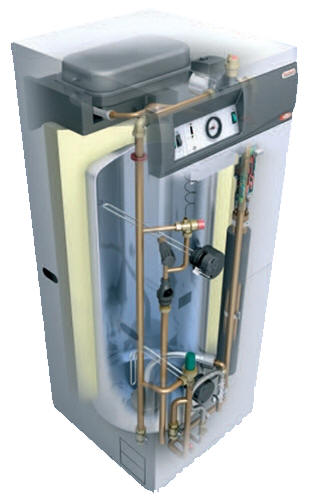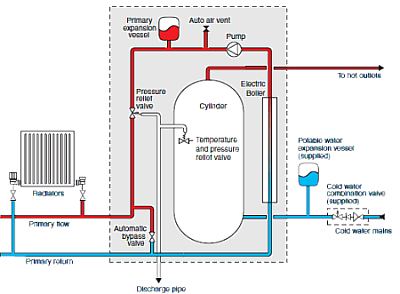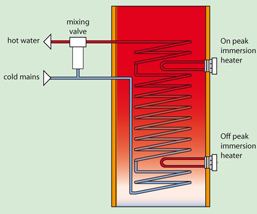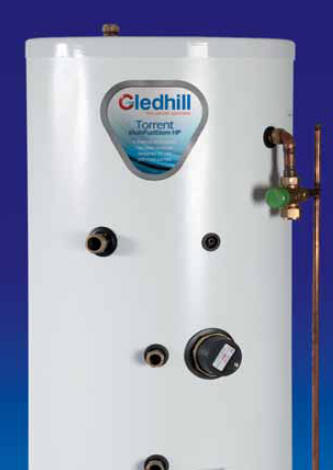Considerations and issues with
Electromax
On the face of things Electromax can
appear to be a gift from heaven. Everything to do with hot water in
a convenient cabinet. But you should consider certain
responsibilities you will inherit as soon as you install one of
these units.
Suitability of an Electromax
Electromax is suited primarily to
apartments (and very small houses) because of it's heat output - a
9kW central heating output is unlikely to be sufficient to heat a
moderately sized house. The all-in-one space saving design does it's
best to minimise the usage of valuable space and will fit neatly
almost anywhere.
Locating an Electromax
Remember, this baby houses an unvented
hot water cylinder. Unvented cylinders require a vent pipe capable
of carrying steam at pressure to the outside of the building in case
they go wrong. And while we are on this subject there are one or two
other things you might consider. |
 |
Liabilities and expenses for Landlords
More often than not an Electromax will be installed in an apartment or
building with multiple occupation. Multiple occupation by it's nature
multiplies the risk and therefore the liabilities an unvented device carries
with it.
The risk to which we allude is officially recognised by way of Building Regulations
(Section G3) whereby any vessel that contains more than 15 litres of hot
water under pressure (unvented cylinders) must be installed, commissioned
and certified by a person competent to do so by definition of the regulation
(you must also notify your local Building Control that an unvented device is
being installed to a property).
In English this means such a device may only
be installed by a qualified person. The reason: An unvented cylinder could
explode if the safe operational temperature and/or pressure is exceeded
should the unit develop a catastrophic fault. For this reason a
temperature/pressure relief valve is necessary on all unvented cylinders to
prevent such a scenario. Furthermore, the operation and condition of the
unit must be inspected annually to ensure such safety equipment is fully
functional. This obviously means an ongoing cost of ownership and the
liability associated with injury that could be caused should the unit
explode. Please click on the following links to see what happens when an
unvented cylinder exceeds the critical point of safety....
There are numerous documented cases of death
and injury caused by unvented hot water cylinders. This is why the G3
Building Regulations exist. And there in a nutshell is your problem. If you
are a landlord you need to consider whether you want to take onboard
responsibility for such a liability - albeit rare because of regulation.
Please note, the Electromax
when installed and maintained correctly will provide you with exactly the
service it claims. It is not our purpose to call into question the ability
of this product to perform. We simply wish to draw your attention to the
realities of the equipment and demonstrate alternatives from which you may
wish to choose.
Options and alternatives to Electromax
|
The simplest way to examine your
options is to firstly split the functions of the Electromax into
component parts.
Essentially the Electromax has two
main functions (excluding any control equipment) - Hot water for
central heating and domestic hot water for bathing.
It is of course possible to provide
both functions by other means. For example, electric central heating
can be provided using an Amptec
electric boiler - indeed this is more or less how the Electromax
does it.
But more interesting are the options
available to provide domestic hot water. The Electromax as we have
discussed contains an unvented hot water cylinder which provides
mains pressure hot water. As it is our purpose to look for similar
alternatives we shall pursue other devices with a similar function
rather than complicate matters by introducing all other cylinder
types. So, we turn to a product known as a Thermal Store. |
 |
What is a Thermal Store?
A Thermal Store is a device that provides mains
pressure hot water but the process by which it does so is very different to
an unvented cylinder. Indeed, the beauty of a Thermal Store is the fact that
it is 'open vented' - this is to say it is vented to atmosphere, or
described another way it is at atmospheric pressure. This key factor means
that a Thermal Store is inherently safe because there can never be an unsafe
pressure build up within the unit leading to an explosion (the problem you
could have with an unvented device). By the nature of the way a Thermal
Store works there is never 15 litres of hot water under pressure at any time
so the G3 Building Regulations do not apply. Because there are no pressure
issues (and never any pressure that might need releasing) a Thermal Store
does not need a safety valve venting to the outside of the building (like an
unvented cylinder does). In short, a Thermal Store gives you the advantages
of mains pressure hot water without any of the dangers.
How does a Thermal Store work?
An untrained person would be excused for
mistaking a Thermal Store for a normal copper cylinder. After all, they look
very similar but the way they work differs immensely (almost in reverse).
A Thermal Store is what it claims to be - a
store for thermal energy. In this case a cylinder full of water is used to
hold said energy. The claim that an open vented store can produce mains
pressure water looks like a contradiction initially until you examine the
very simple process. By immersing a large and very efficient heat exchanger
within the hot water in the thermal store a process is created whereby mains
pressure cold water passing through the heat exchanger draws energy from the
store, emerging at the outlet as mains pressure hot water. It is that
simple. The process is entirely safe.
There are numerous products that exploit the
principle of thermal storage and over the years it has become a preferred
method because of the inherent performance with safety.
|
 |
|
Schematic of a 'Direct' Thermal Store |
|
|
So what are your alternatives to an Electromax?
You need to ask yourself several questions before you decide.
Firstly, does it really matter how your system appears? Will it be
visible or tucked away in a cupboard? The aesthetics of hot water devices
are rarely an issue, but the might be!
Secondly, do you have a good mains water supply to the property? If
your incoming supply is poor then a mains pressure systems might be the last
thing you should consider. (If you would like further advice on this matter
please contact us)
Thirdly, do you want an unvented cylinder in your property?
Fourthly, does it matter if the functions of electric central heating
and electric domestic hot water are contained in the same unit or produced
by separate pieces of equipment?
Thermal stores are available in many shapes and sizes and with a range of
extra functions. You are always welcome to call for
more detailed advice, but you might like to begin your mission of
discovery by looking at the following that will provide you with electric
central heating or electric mains pressure hot water utilising a thermal
store.
|
Amptec Electric
Boiler
|
|
 |
|
Electric central heating boiler |
|
|
|
Pulsacoil
|
|
 |
|
Mains pressure hot water from a thermal store in a
metal cabinet |
|
|
|
Torrent Multifuel
|
|
 |
|
Cylindrical thermal store with additional
connections for other heat sources |
|
|
|
Combination T'
Store
|
|
 |
|
Cylindrical thermal store with integral cold water
header |
|
|
|